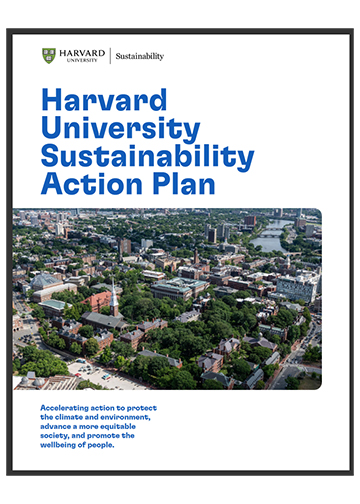Interested in offsetting your travel carbon footprint? Click here.
Are you traveling soon, but feel concerned about the carbon footprint of your flight or drive? Planes and cars release greenhouse gas emissions (GHG) such as carbon dioxide, along with other pollutants when fossil fuels are consumed during travel. In fact, tourism accounts for about 8% of the world’s carbon emissions, contributing significantly to climate change. Pollution from travel also has major impacts on human health. One approach to help offset the negative impact of travel on the environment is to invest in carbon credits sold by projects that reduce GHG in the atmosphere and may also provide other societal benefits in areas such as health and wellbeing.
Not all carbon credits used for offsetting are created equal - project quality varies, with some not delivering the expected GHG reductions. Given this variability, members of the Harvard Business School (HBS) community have asked HBS to provide carbon credit recommendations to offset their travel emissions. After exploring options, HBS is suggesting travelers consider the CNaught carbon credit portfolio which was curated for HBS to manage risk and meet our high standards and criteria on climate, health, and wellbeing. As an example, offsetting the emissions of an economy flight from San Francisco, CA to Boston, MA would cost $13.50
To meet those goals, CNaught curated a project portfolio with 99.5% of the carbon credits rated a BBB or above by Calyx Global, meaning they are more likely to deliver their expected GHG reductions (see FAQ for more detail). Calyx Global is a stringent carbon credit rating organization ranked as the best by Carbon Market Watch and recommended by Harvard’s Office for Sustainability. At least 9.5% of those projects will also provide health and wellbeing benefits. The remaining 0.5% is a modest investment in Frontier projects which are made up of promising, innovative, yet higher risk permanent carbon removal technologies ready to scale, which are important as these technologies are needed to address future climate change. Specific projects within the portfolio may vary based on availability but will meet these criteria.
In addition to this initiative, HBS has significantly reduced its GHG emissions along with implementing a wide variety of sustainability initiatives aligned with the University's Sustainability Action Plan. This plan outlines Harvard’s goals to be Fossil Fuel Neutral by 2026 and Fossil Fuel Free by 2050 for campus energy use and vehicles (Scope 1 and 2). Harvard uses the term “fossil fuel” instead of “carbon” to emphasize the health consequences from fossil fuel pollution. This pollution disproportionately impacts certain communities, including those living near power plants.” In addition to the Scope 1 and 2 targets, the plan includes objectives to reduce Scope 3 emissions from travel (with an emphasis on air travel) and the supply chain.
Questions? See FAQs below on the carbon credit project portfolio along with HBS Sustainability highlights or email sustainability@hbs.edu. You can also learn more about carbon credits from a HBS professor and alum by checking out this article: “What leaders need to know about carbon credits”.
FAQs
What are carbon credits and how do they offset emissions?
Carbon credits are one tool to reduce greenhouse gas emissions (GHG). They are an investment in projects that reduce GHG emissions to counteract the emissions produced by the purchaser. These projects sell carbon credits that individuals or organizations can use to offset their emissions. Depending on the project type, there may be additional societal benefits (i.e. health, wellbeing, economic) as well as the GHG reduction. There are few high-quality carbon credit projects available in the market today.
Why is carbon offsetting important?
Carbon credits are a tool to help limit climate change now while more comprehensive solutions are developed and implemented. Reducing and removing GHG emissions now is critical, as climate change caused by emissions from human activities is already affecting every region on Earth. This has an adverse impact on human health (pdf) in many ways including extreme heat, extreme weather events, air pollution along with increases in diseases and disease transmission.
According to the U.S. EPA’s Climate Change Indicators in the United States: Fifth Edition, the impacts of climate change are not felt equally: “Some communities experience disproportionate impacts because of existing vulnerabilities, historical patterns of inequity, socioeconomic disparities, and systemic environmental injustices. People who already face the greatest burdens are often the ones affected most by climate change.”
What criteria were used to create the CNaught Project Portfolio for HBS?
CNaught has curated a portfolio of carbon credits to meet the HBS criteria of delivering climate impact along with health & wellbeing benefits (all priorities in Harvard’s Sustainability Action Plan). The portfolio includes credits that Calyx Global, a credible and rigorous carbon credit rating agency, has rated highly as they are more likely to deliver the expected GHG reductions: 90% of the credits are rated A or above and may or may not have additional societal benefits, 9.5% are BBB or above and will include health and wellbeing benefits.
Calyx Global was rated the best carbon credit rater by Carbon Market Watch and is used by other large companies like Meta and Salesforce. Calyx Global was recommended by Harvard’s Office for Sustainability for selecting previous carbon credit purchases by HKS, and by HBS to partially offset academic student travel in 2024.
There is also a 0.5% investment in Frontier projects made up of promising, innovative permanent carbon removal technologies ready to scale. Frontier projects carry more risk in terms of GHG reduction certainty, but these types of technologies will play a crucial role in addressing climate change in the future, so it is important to help catalyze the market.
Specific projects within the portfolio may vary based on availability but will meet these criteria.
Why is it important to HBS that the carbon credit portfolio addresses health and wellbeing in addition to climate?
In addition to climate, health and wellbeing for all are key priorities at Harvard as noted in the Harvard Sustainability Action Plan, therefore CNaught will ensure that at least 9.5% of the project portfolio is made up of projects with health & wellbeing benefits.
Emphasis on climate, health and wellbeing for all is also reflected in Harvard’s use of the term “fossil fuel” in our climate action goals instead of the more common “carbon” to emphasize the human health consequences from fossil fuel pollution. Two studies, one of which involved Harvard, estimate that 5-8 million people die annually from fossil fuel pollution. This pollution disproportionately impacts certain communities, including those living near power plants.”
Given this emphasis on health and wellbeing, HBS wanted to ensure the suggested carbon credit portfolio for offsetting travel emissions reflected those priorities.
How does the project portfolio from CNaught manage the risks inherent in the carbon credit market?
CNaught subscribes to a stringent carbon credit rating platform developed by Calyx Global. Calyx Global was rated the best carbon credit rater by Carbon Market Watch, is used by other large companies like Meta and Salesforce, and was recommended by Harvard’s Office for Sustainability for selecting previous HBS and HKS carbon credit purchases. Projects with higher GHG ratings from Calyx Global are more likely to deliver their expected GHG reductions.
Calyx Global assesses carbon credits against a number of potential risks that could impact a project’s claim of delivering GHG reductions or removals such as: additionality (the risk that the carbon revenue is not the reason the emissions reduction/removal project is implemented as it would have happened anyway for other reasons); permanence (possibility of emission reduction reversal, e.g., a planted tree could be burned in a wildfire); and accurate quantification of credits from GHG reductions (to prevent over-crediting).
Calyx Global also provides SDG Impact Ratings, where they rate the level of societal benefit the project is providing related to the United Nation’s 17 Sustainable Development Goals (SDG). In addition to environmental goals, the SDGs include social and economic goals such as ending poverty, ensuring health & wellbeing, and providing decent work & sustainable economic growth.
Despite CNaught’s efforts to reduce risk by curating a portfolio of 99.5% carbon credits rated BBB or better by Calyx, there is no guarantee projects will deliver the expected climate and societal impacts.
Interested in learning more from a HBS faculty member about carbon credits?
HBS Professor Toffel has co-written an article titled, “What leaders need to know about carbon credits”, which covers: the types of projects that create carbon credits used for offsetting; the key players, such as carbon credit verifiers, brokers, and rating agencies; and, the types of risks related to projects delivering the promised GHG emissions, such as additionality and permanence.
Many organizations are using carbon credits as a strategy to meet their carbon neutral goals, so it is important that leaders are purchasing meaningful carbon credits that are delivering on their expected GHG reductions and help reduce reputational risk.

What are Harvard and HBS doing on Climate & Sustainability?
Harvard’s Sustainability Action Plan focuses on climate, health, and wellbeing for all. The plan includes the goals of being fossil fuel neutral by 2026 and fossil fuel free by 2050 for emissions from campus energy use and the vehicles (Scope 1 and 2 emissions). “Harvard uses the term “fossil fuel” instead of “carbon” to emphasize the health consequences from fossil fuel pollution. This pollution disproportionately impacts certain communities, including those living near power plants.”
In addition to the Scope 1 and 2 targets, the plan includes objectives to reduce Scope 3 emissions from travel (with an emphasis on air travel) and supply chain.
HBS has made significant reductions in our Scope 1 and 2 GHG emissions through hundreds of energy conservation measures and more sustainable building and renovation practices. HBS has installed solar PV* and solar thermal along with green roofs on many of our buildings. (*Note: SRECs, which represent the environmental benefit, are sold to the Harvard Utility to meet State Renewable Energy Requirements.)
HBS has started to reduce our Scope 3 emissions with initiatives that include targeting lower embodied carbon building materials for renovation projects and increasing our plant-based food options in both our dining venues & catering menus.
HBS incorporates a number of sustainability practices in its events. For example, at Commencement & Reunions we utilize water stations for guests to reduce bottled water plastic waste; donate leftover food to Food for Free; provide waste sorting stations to divert waste into the compost (which is anaerobically digested) or recycle streams; use reusable dishes when feasible or compostable single-use to-go items; and select menu items with lower greenhouse gas emissions in mind.
HBS has also reduced waste, implemented more sustainable landscaping practices, and installed bee hives that help support bee health research.


